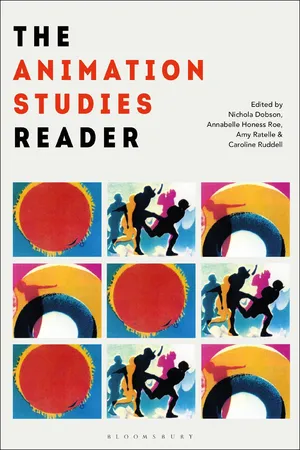
The Animation Studies Reader
Nichola Dobson, Annabelle Honess Roe, Amy Ratelle, Caroline Ruddell
- 352 pages
- English
- ePUB (mobile friendly)
- Available on iOS & Android
The Animation Studies Reader
Nichola Dobson, Annabelle Honess Roe, Amy Ratelle, Caroline Ruddell
About This Book
The Animation Studies Reader brings together both key writings within animation studies and new material in emerging areas of the field. The collection provides readers with seminal texts that ground animation studies within the contexts of theory and aesthetics, form and genre, and issues of representation. The first section collates key readings on animation theory, on how we might conceptualise animation, and on some of the fundamental qualities of animation. New material is also introduced in this section specifically addressing questions raised by the nature, style and materiality of animation. The second section outlines some of the main forms that animation takes, which includes discussions of genre. Although this section cannot be exhaustive, the material chosen is particularly useful as it provides samples of analysis that can illuminate some of the issues the first section of the book raises. The third section focuses on issues of representation and how the medium of animation might have an impact on how bodies, gender, sexuality, race and ethnicity are represented. These representations can only be read through an understanding of the questions that the first two sections of the book raise; we can only decode these representations if we take into account form and genre, and theoretical conceptualisations such as visual pleasure, spectacle, the uncanny, realism etc.
Frequently asked questions
Information
Table of contents
- Cover
- Halftitle Page
- Title Page
- Contents
- List of Figures
- List of Contributors
- Acknowledgements
- Introduction
- Part 1: Theory, Philosophy and Concepts
- Part 2: Forms and Genres
- Part 3: Representation: Frames and Contexts
- Index
- Imprint